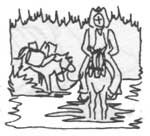|
The Clearwater Story: A History of the Clearwater National Forest |

|

Chapter 27
Packing
In the early days of the Forest Service travel was by horseback. Each Ranger was required to have a saddlehorse and each one usually had one or more pack animals to carry his food supplies and camping equipment. The practice of requiring Rangers to furnish their own stock was discontinued in 1924. Thereafter, the Forest Service furnished all the stock but some Rangers kept their horses for a few years. I know of no Ranger who owned stock after 1928 in Northern Idaho and Western Montana. In the grazing forests in eastern Montana some Rangers preferred to have their own stock.
Packing to large fires or to construction projects was at first handled by contract packers and their packstrings. Among the first packers were Bill Parry, the Stonebraker Bros. [Sumner, Toode (Toad)], George Renshaw - Decker, Mackey Williams and McDaniels in the Clearwater country and Williams - Young at Superior. Likely there were others in Montana. Before the creation of the Forests these outfits had been packing for settlers and mining companies. Many of them had packed into the mines around Buffalo Hump and Elk City.
The transportation of food and equipment by packhorse and mules in the Clearwater country has been around as long as the horse itself has. The Nez Perce Indians did not use the travois. They used the packsaddle and some of their old saddles do not differ in design very much from the one Robinette patented. They used elk horns instead of steel.
The diamond hitch is a system of tying the load onto the packsaddle with a rope and a cinch. It gets its name from the diamond the rope forms on the top of the load. This system was used all over the Northwest with few exceptions. In the first Ranger examinations the would-be Ranger had to demonstrate that he could throw the diamond hitch. One of the exceptions in the Clearwater was a man named Mackey Williams who used the cargo system of packing. I don't know whether he invented it or not. There may have been men on the Clearwater who used it before him, but I never heard of them.
In about 1910 some of the Forest Service packers began using the cargo system and it spread rapidly in the Clearwater and Nezperce country. Soon the commercial packers began adopting it. For instance the Stonebraker Brothers used the diamond hitch, I am told by Bill Harris an old packer, but when I knew them and saw them packing in 1922 they were using the cargo system. Slowly the cargo system spread across Region One. Lloyd Hornby, who had been Supervisor of the Clearwater National Forest, took it to the Flathead Forest when he became Supervisor there in 1924. I was the first Ranger to use it on the Blackfeet Forest in 1925. Soon thereafter there were many good packers that did not know how to throw the diamond hitch. I haven't thrown one for forty years, but I will bet I can still do it.
After 1919 the large commercial pack outfits began getting out of the packing business. There was little packing to do except for the Forest Service and to them only in bad fire seasons. This drop in available packstock caused the Forest Service to build up their own strings.
Winter ranges for pack stock were at first on an individual forest basis but in a few years the Clearwater and Nezperce were leasing winter pastures together. As the numbers of pack animals grew this became increasingly hard to do. The winter range at Parma came into use in about 1934. At this same time or a year earlier the number of packstock needed began to decline. As roads and landing fields were built supplies were more and more being delivered by truck or airplane. Next came the smokejumpers, then aerial detection, so the number of stock dropped. Now the helicopter has taken over. So the winter range went out of use in 1967.
As an example of the use of pack stock, take the year 1927 when my brother was head of the supply base at the Bungalow. That year each ranger district had two pack strings and there were ten more operating out of the Bungalow. A similar supply system once operated at Pete King Ranger Station with John (Cap) Rice in charge. Each pack string consisted of a saddle horse, a bell mare, and seven mules. I estimate the Clearwater, as today, had about 225 head of saddle and pack stock. As of 1976 the forest had 18 head, nine at Lochsa and since this stock is used for travel into the wilderness the number of stock likely will remain at this number.
| <<< Previous | <<< Contents>>> | Next >>> |
|
clearwater/story/chap27.htm Last Updated: 29-Feb-2012 |